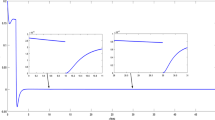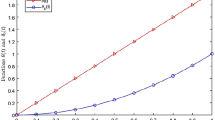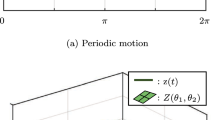Abstract
Timed Event Graphs (TEGs) can be described by time invariant (max,+) linear systems. This formalism has been studied for modelling, analysis and control synthesis for decision-free timed Discrete Event Systems (DESs), for instance specific manufacturing processes or transportation networks operating under a given logical schedule. However, many applications exhibit time-variant behaviour, which cannot be modelled in a standard TEG framework. In this paper we extend the class of TEGs in order to include certain periodic time-variant behaviours. This extended class of TEGs is called Periodic Time-variant Event Graphs (PTEGs). It is shown that the input-output behaviour of these systems can be described by means of ultimately periodic series in a dioid of formal power series. These series represent transfer functions of PTEGs and are a convenient basis for performance analysis and controller synthesis.










Similar content being viewed by others
Notes
In Bouillard and Thierry (2008) a similar approach, the so called network calculus, was presented to analyze communication networks.
References
Amari S, Demongodin I, Loiseau JJ, Martinez C (2012) Max-plus control design for temporal constraints meeting in timed event graphs. IEEE Trans Autom Control 57(2):462–467. https://doi.org/10.1109/TAC.2011.2164735
Baccelli F, Cohen G, Olsder G, Quadrat J (1992) Synchronization and linearity: an algebra for discrete event systems. Wiley, New York
Bouillard A, Thierry É (2008) An algorithmic toolbox for network calculus. Discret Event Dyn Syst 18(1): 3–49
Brat GP, Garg VK (1998) A (max,+) algebra for non-stationary periodic timed discrete event systems. In: Proceedings of the 4th international workshop on discrete event systems (WODES), pp 237–242
Cofer DD, Garg VK (1993) A generalized max-algebra model for performance analysis of timed and untimed discrete event systems. In: American control conference 1993, pp 2288–2292
Cohen G, Gaubert S, Nikoukhah R, Quadrat JP (1991) Second order theory of min-linear systems and its application to discrete event systems. In: Proceedings of the 30th IEEE conference on decision and control, vol 2, pp 1511–1516. https://doi.org/10.1109/CDC.1991.261654
Cottenceau B, Hardouin L, Boimond JL (2014a) Modeling and control of weight-balanced timed event graphs in dioids. IEEE Trans Autom Control 59 (5):1219–1231. https://doi.org/10.1109/TAC.2013.2294822
Cottenceau B, Lahaye S, Hardouin L (2014b) Modeling of time-varying (max,+) systems by means of weighted timed event graphs. In: 12th IFAC-IEEE Int. workshop on discrete event systems (WODES. Paris
Cottenceau B, Hardouin L, Trunk J (2017) Weight-balanced timed event graphs to model periodic phenomena in manufacturing systems. IEEE Trans Autom Sci Eng 14(4):1731–1742
Cottenceau B, Hardouin L, Trunk J (2019) (event and time variant operators). http://perso-laris.univ-angers.fr/cottenceau/etvo.html
David-Henriet X, Raisch J, Hardouin L, Cottenceau B (2014) Modeling and control for max-plus systems with partial synchronization. In: Proceedings of the 12th IFAC-IEEE international workshop on discrete event systems (WODES), Paris, pp 105–110
David-Henriet X, Raisch J, Hardouin L, Cottenceau B (2015) Modeling and control for (max, +)-linear systems with set-based constraints. In: IEEE International conference on automation science and engineering (CASE), pp 1369–1374. https://doi.org/10.1109/CoASE.2015.7294289
Declerck P (2013) Discrete event systems in dioid algebra and conventional algebra. Wiley
Gaubert S (1992) Théorie des systèmes linéaires dans les dioïdes. Ph.D. dissertation (in French). Ecole des Mines de Paris, Paris
Gaubert S, Klimann C (1991) Rational computation in dioid algebra and its application to performance evaluation of discrete event systems. In: Algebraic computing in control. Springer, pp 241–252
Graham RL, Knuth DE, Patashnik O (1989) Concrete mathematics: a foundation for computer science. Addison-Wesley Longman Publishing Co., Inc., Boston
Hardouin L, Le Corronc E, Cottenceau B (2009) Minmaxgd a software tools to handle series in (max, +) algebra. In: SIAM conference on computational science and engineering, Miami
Hardouin L, Shang Y, Maia CA, Cottenceau B (2017) Observer-based controllers for max-plus linear systems. IEEE Trans Autom Control 62(5):2153–2165. https://doi.org/10.1109/TAC.2016.2604562
Hardouin L, Cottenceau B, Shang Y, Raisch J (2018) Control and state estimation for max-plus linear systems. Found Trends Syst Control 6(1):1–116. https://doi.org/10.1561/2600000013
Heidergott B, Olsder G, van der Woude J (2005) Max plus at work: modeling and analysis of synchronized systems: a course on max-plus algebra and its applications (Princeton Series in Applied Mathematics). Princeton University Press
Lahaye S, Boimond JL, Ferrier JL (2008) Just-in-time control of time-varying discrete event dynamic systems in (max,+) algebra. Int J Prod Res 46(19):5337–5348. https://doi.org/10.1080/00207540802273777
Libeaut L, Loiseau JJ (1996) Model matching for timed event graphs. IFAC Proc Vol 29(1):4807–4812. https://doi.org/10.1016/S1474-6670(17)58441-4. 13th World Congress of IFAC, 1996, San Francisco USA, 30 June - 5 July
Maia CA, Hardouin L, Santos-Mendes R, Cottenceau B (2003) Optimal closed-loop control of timed event graphs in dioids. IEEE Trans Autom Control 48 (12):2284–2287
Schutter BD, van den Boom T (2001) Model predictive control for max-plus-linear discrete event systems. Automatica 37 (7):1049–1056. https://doi.org/10.1016/S0005-1098(01)00054-1
Trunk J, Cottenceau B, Hardouin L, Raisch J (2018) Model decomposition of timed event graphs under partial synchronization in dioids. IFAC-PapersOnLine 51(7):198–205. https://doi.org/10.1016/j.ifacol.2018.06.301, 14th IFAC Workshop on Discrete Event Systems WODES 2018
Author information
Authors and Affiliations
Corresponding author
Additional information
Publisher’s note
Springer Nature remains neutral with regard to jurisdictional claims in published maps and institutional affiliations.
This article belongs to the Topical Collection: Smart Manufacturing - A New DES Frontier
Guest Editors: Rong Su and Bengt Lennartson
Appendices
Appendix A: Formula of residuation
In a complete dioid, the following formula hold for the residuation of left and right multiplication see Baccelli et al. (1992, Chap.4).



Appendix B: Formula for floor and ceil operations (Graham et al. 1989)
For \(x\in \mathbb {R}\),
For \(x\in \mathbb {R}\), \(m\in \mathbb {Z}\) and \(n \in \mathbb {N}\),
For \(m\in \mathbb {Z}\) and \(n \in \mathbb {N}\),
Appendix C: Proofs
1.1 C.1 Proof of Proposition 1 (relations between T-operators)
Let us recall that \(y\in \mathbb {R},\ \forall n \in \mathbb {Z}, \lceil y+n \rceil = \lceil y \rceil + n\). To prove Eq. 16, because of Definition 6, ∀x ∈Σ,
Second,
To prove Eq. 17, note that ⌈(a + ς)/ω⌉ω = ⌈ς/ω⌉ω + ⌈(a + ς − ω⌈ς/ω⌉)/ω⌉ω, and therefore
since: \(\lceil x(k)\slash \omega \rceil \in \mathbb {Z}\) and − 1 < (ς − ω⌈ς/ω⌉)/ω ≤ 0, finally,
1.2 C.2 Proof of Proposition 2 (operator representation of a release-time-function)
First recall that release-time-functions are nondecreasing. Hence, in Eq. 9, nω− 1 − ω ≤ n0 ≤ n1 ≤⋯ ≤ nω− 1 ≤ n0 + ω. Moreover, recall that the release-time-function \(\mathcal {R}_{\delta ^{\varsigma }{\Delta }_{\omega } \delta ^{\varsigma ^{\prime }}}(\xi )\) of an operator \(\delta ^{\varsigma }{\Delta }_{\omega } \delta ^{\varsigma ^{\prime }}\) is defined by
where ξ = x(k) is a date. Thus, \(\mathcal {R}_{p}\) associated with Eq. 21 is
We can evaluate the expression Eq. 35 for all dates ξ. If we choose \(\xi = j\omega ,\ \ \forall j\in \mathbb {Z}_{max}\), we have
Similarly ∀i = {1,⋯ , (ω − 1)},
Hence we have shown that,
1.3 C.3 Proof of Proposition 5 (product of polynomials)
Due to Eq. 23\(p_{1}={\bigoplus }_{i=1}^{I}v_i\gamma ^{n_i}\) and \(p_{2}={\bigoplus }_{l=1}^{L}\bar {v}_l\gamma ^{\nu _l}\) can be expressed with a common period ω = lcm(ω1,ω2):
Then the product is obtained by
with Ji ≤ ω, Kl ≤ ω and complexity \(\mathcal {O}(2\omega I L)\).
1.4 C.4 Proof of Lemma 1 (ultimate domination)
Recall that \((\gamma ^{\nu } \delta ^{\tau })^{*}\delta ^{\varsigma }{\Delta }_{\omega } \delta ^{\varsigma ^{\prime }}= \delta ^{\varsigma }{\Delta }_{\omega } \delta ^{\varsigma ^{\prime }}(\gamma ^{\nu } \delta ^{\tau })^{*}\) (Proposition 4, therefore \(\tau _{1} = k_{1}\omega , \ k_{1}\in \mathbb {N}\) (resp. \(\tau _{2} = k_{2}\omega , k_{2}\in \mathbb {N}\)) and inequality Eq. 26 can be expressed by
It exists a positive integer K such that inequality Eq. 26 holds, if and only if \(x \in \mathbb {N},\forall x \geq K,\ \exists y \in \mathbb {N}\) such that
Since \(\delta ^{\varsigma _{1}}{\Delta }_{\omega } \delta ^{{\varsigma }_{1}^{\prime }}\) and \(\delta ^{\varsigma _{2}}{\Delta }_{\omega } \delta ^{{\varsigma }_{2}^{\prime }}\) are assumed to be canonical monomials then \(\varsigma _{1}^{\prime }<\omega \) and \(\varsigma _{2}^{\prime }<\omega \). Furthermore, since s1 is in the commute form τ1 is a multiple of ω and therefore \(\tau _{1}+\varsigma _{1}^{\prime }>\varsigma _{2}^{\prime }\). We can now rewrite Eq. 36,
Such an integer \(y \in \mathbb {Z}\) exists, if
This holds for a sufficiently large x, given by
In addition y has to be positive, which is guaranteed, if \(x \geq K_{2}= \left \lceil (n_{1}-n_{2})\slash v_{2} \right \rceil \). Hence, we can give an upper bound for K in Eq. 26, i.e., \(K = \max \limits \left (0,K_{1},K_{2}\right )\).
1.5 C.5 Proof of Proposition 6 (sum of ultimately periodic series)
We distinguish two cases first: σ(s1) = σ(s2). By defining N = lcm(ν1,ν2) = k1ν1 = k2ν2 and T = k1τ1 = k2τ2, then \((\gamma ^{\nu _{1}}\delta ^{\tau _{1}})^{*}\) and \((\gamma ^{\nu _{2}}\delta ^{\tau _{2}})^{*}\) can be written as
Thus the sum can be written as: \(s_{1} \oplus s_{2} = p_{1} \oplus p_{2} \oplus (q_{1}q_{1}^{\prime }\oplus q_{2}q_{2}^{\prime })(\gamma ^N\delta ^T)^{*}\).
Second, σ(s1) > σ(s2). Note that series s1,s2 can be expressed with a common period thus one can write,
Due to Lemma 1, we can show that s1 ⊕ s2 is ultimately dominated by s1.
1.6 C.6 Proof of Proposition 7 (product of ultimately periodic series)
Recall that s1 and s2 can be expressed in the commute form, Proposition 4. Then product of two series \(s_{1} = p_{1}\oplus q_{1}(\gamma ^{\nu _{1}}\delta ^{\tau _{1}})^{*}\) and \(s_{2}= p_{2}\oplus (\gamma ^{\nu _{2}}\delta ^{\tau _{2}})^{*}q_{2}\) can be written as
Clearly, p1p2 is a polynomial (Proposition 5). \((\gamma ^{\nu _{1}}\delta ^{\tau _{1}})^{*}(\gamma ^{\nu _{2}}\delta ^{\tau _{2}})^{*} = (\gamma ^{\nu _{1}}\delta ^{\tau _{1}} \oplus \gamma ^{\nu _{2}}\delta ^{\tau _{2}})^{*} = s_3\) is an ultimately periodic series in \({\mathcal{M}}_{in}^{ax} [\![ \gamma ,\delta ]\!]\), therefore it is also a series in \(\mathcal {T}^{*} [\![ \gamma ]\!]\) and \(q_{1}s_{3}q_{2} = \tilde {s}_{3}\) as well. \(p_{1}q_{2}(\gamma ^{\nu _{2}}\delta ^{\tau _{2}})^{*} = \tilde {s}_{2}\) (resp. \(p_{2}q_{1}(\gamma ^{\nu _{1}}\delta ^{\tau _{1}})^{*}= \tilde {s}_{1}\)) are two series in \(\mathcal {T}^{*} [\![ \gamma ]\!]\). Finally we have a sum \(p_{1}p_{2}\oplus \tilde {s}_{1}\oplus \tilde {s}_{2}\oplus \tilde {s}_{3}\) of ultimately periodic series in \(\mathcal {T}^{*} [\![ \gamma ]\!]\), Proposition 6 Appendix C5.
1.7 C.7 Proof of Proposition 8 (Kleene star of a polynomial)
We first investigate a particular case, in which the star of a series in \(\mathcal {T}^{*} [\![ \gamma ]\!]\) can be calculated similarly to the star of a simple monomial in \(\mathcal {T}^{*} [\![ \gamma ]\!]\), see Eq. 24. Consider the following series \(s\in \mathcal {T}^{*} [\![ \gamma ]\!]\) where w.l.o.g. τ is a multiple of ω, see Proposition 4 commute form,
where \(\tilde {S}= P\oplus Q(\gamma ^{\nu }\delta ^{\tau })^{*}\in {\mathcal{M}}_{in}^{ax} [\![ \gamma ,\delta ]\!]\). The product ss can be written as
where \(\hat {S}= P^{\prime }\oplus Q^{\prime }(\gamma ^{\nu }\delta ^{\tau })^{*}\in {\mathcal{M}}_{in}^{ax} [\![ \gamma ,\delta ]\!]\) is a series given by
The star s∗ is an ultimately periodic series in \(\mathcal {T}^{*} [\![ \gamma ]\!]\), which can be obtained by
Second, a polynomial in \(\mathcal {T}^{*} [\![ \gamma ]\!]\) can be partitioned into a sum of sub-polynomials in the following form
where, \(p_l = \bigoplus _{i}\gamma ^{\nu _i}\delta ^{\varsigma _i}{\Delta }_{\omega } \delta ^{-l}\). Since (a ⊕ b)∗ = (a∗b)∗a∗,
Let us define by \(\bar {p}_{l} := p_0\oplus {\cdots } \oplus p_l\), thus we can write the star \(\bar {p}_{l}^{*}\) in a recursive form
When we choose l = 1 we obtain \(\bar {p}_{1}^{*} = \left (p_0^{*}p_{1} \right )^{*}p_0^{*}\), since \(\bar {p}_0=p_0= {\bigoplus }_{i =1}^{I}\gamma ^{\nu _{1i}}\delta ^{\varsigma _{1i}}{\Delta }_{\omega }\). Due to Eq. 37, \(p_0^{*}\) is given by
This star can be rewritten as \( p_0^{*} = \mathrm {e} \oplus (\tilde {S}_0){\Delta }_{\omega }\) where \(\tilde {S}_0\) is a series in \({\mathcal{M}}_{in}^{ax} [\![ \gamma ,\delta ]\!]\). The product \(p_0^{*}p_{1}\) is ultimately periodic series in \(\mathcal {T}^{*} [\![ \gamma ]\!]\), since
where \(\tilde {S}_{01}\) is again a series in \({\mathcal{M}}_{in}^{ax} [\![ \gamma ,\delta ]\!]\). Therefore, the star \((p_0^{*}p_{1})^{*}\) can be calculated by using Eq. 37. It is an ultimately periodic series \(\mathcal {T}^{*} [\![ \gamma ]\!]\). Then \(\bar {p}_{1}^{*} = (p_0^{*}p_{1})^{*}p_0^{*}\) is the product of two ultimately periodic series in \(\mathcal {T}^{*} [\![ \gamma ]\!]\), see Proposition 7 Appendix C6. In a similar way with \(\bar {p}_{1}^{*}\) we can solve successively the recursive Eq. 38 ∀i ∈{1,⋯,ω − 1}.
1.8 C.8 Proof of Proposition 9 (Kleene star of an ultimately periodic series)
Recall that for r = (γνδτ), qr∗ = r∗q, Proposition 4. The star of ultimately periodic series can be rewritten as a star of polynomials s∗ = (p ⊕ qr∗)∗ = p∗(qr∗p∗)∗ = p∗(q(r ⊕ p)∗)∗ = p∗(e ⊕ q(q ⊕ r ⊕ p)∗), Baccelli et al. (1992).
Rights and permissions
About this article
Cite this article
Trunk, J., Cottenceau, B., Hardouin, L. et al. Modelling and control of periodic time-variant event graphs in dioids. Discrete Event Dyn Syst 30, 269–300 (2020). https://doi.org/10.1007/s10626-019-00304-x
Received:
Accepted:
Published:
Issue Date:
DOI: https://doi.org/10.1007/s10626-019-00304-x




